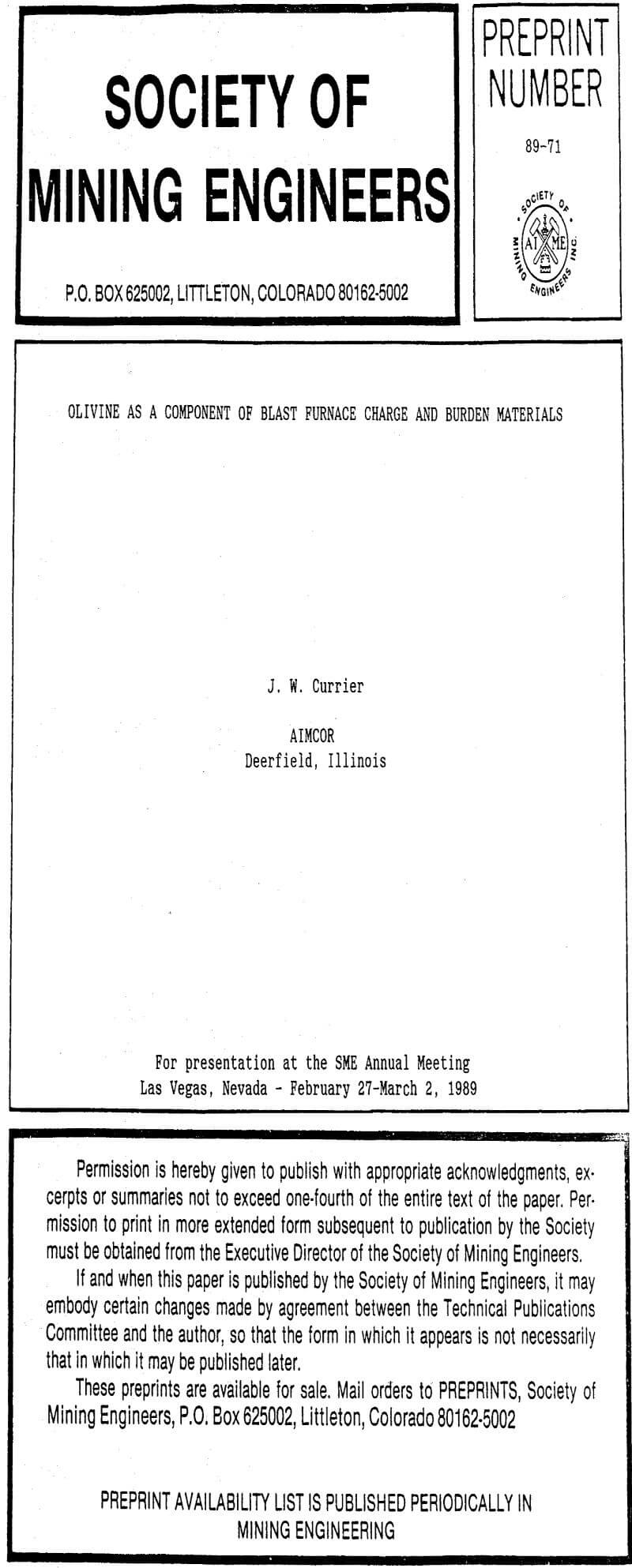In the case of pellets it was observed that incremental additions of olivine to any of a series of pellet concentrates invariably caused the pellets to become progressively more ferromagnetic after induration. At first, it was assumed that what little magnesioferrite formed in such pellets stabilized magnetite, a comparable spinel structure, in solid solution. However a systematic study showed that near quantitative yields of virtually pure magnesioferrite were produced during induration of green pellets containing up to 4 percent of fine olivine. The gangue content and mineral natures of the pellet concentrates had little to do with the formation of this magnesioferrite phase.
The quantitative repartitioning of magnesia, a strong base silica to the ferric oxide phase was quite unexpected. One would not expect a base like magnesia to partition from a strong acid to a weak acid. Furthermore, when it was recognized that 1 part by weight of MgO or 2.25 parts of olivine would produce 5.0 parts by weight of magnesioferrite (MgFe2O4), this spinel phase became the obvious source of the ferromagnetic properties. When one considers that magnesioferrite has a density well below that of hematite, the principal phase of an indurated pellet, it becomes clear that as much as 4 percent by weight of olivine can produce well over 10 volume percent of magnesioferrite in a pellet system. The facility with which the ferrite phase forms from olivine, and the leveraged stoichiometry of the formation of the magnesioferrite phase from olivine are particularly noteworthy.
In a few instances, partially reacted grains of olivine were found in scanning electron micrographs of + polished sections in these pellet systems. These olivine grains were inevitably surrounded by radiating, alternating, spoke-like arrays of magnesioferrite and silica phases. The ferrite spokes continued into a surrounding zone of magnesioferrite which, in turn, was embedded in the hematite matrix of the pellet.
This demonstrates the facility with which the magnesia of olivine was diffusing byway of the intervening magnesioferrite phase (MF) to convert the surrounding hematite (H) at the MF-H boundary to more MF. The ease with which the magnesia avoided the silica co-product (S) was surprising. It suggests that the magnesium atoms are highly mobile at elevated temperatures in these iron (III) oxide systems. It is noteworthy that the mobility of magnesium in the spinel MF has no counterpart for the iron (II) oxide component of the comparable spinel, magnetite (M). If a divalent iron ion should migrate in a similar manner in magnetite, its valance state would also change so that there would be no net migration of the iron (II) oxide. This distinction between the mobility of magnesium and iron (II) ions in spinel structures is important in the reduction process, as we shall see later.
It follows that magnesia, unlike lime, tends to partition quantitatively from silica to the iron (III) oxide phases of prepared burden materials during induration or sintering processes. Lime, on the other hand, prefers to partition to or remain in the silica and gangue constituents of these burden materials. It is surprising that this difference was never fully appreciated in any of the numerous studies of iron oxide burden systems containing silica, lime and magnesia as minor components. It is even more surprising that magnesia partitions so readily to the iron oxide portions of such systems in the absence of lime.
Lime’s unexpected negative influence on the formation of the magnesioferrite phase remains to be explained. It was found that additions of lime to pellet concentrates effectively blocked the assimilation of olivine grains to form MF and S phases. Similarly, dolomite does not produce quantitative yields of magnesioferrite during induration. Instead, low melting calcium silicate phases coat and kinetically blocked the diffusion of magnesia into the iron oxide phases of these systems.
Since the calcium and silica eutectic is the lowest melting component in these burden materials, this melt serves to coat magnesia sources like dolomite or olivine and to inhibit the repartitioning of their magnesia to the iron oxide phases. In the case of dolomite, the silica is derived from the gangue of the pellet concentrate. Unlike the silica of olivine, the calcium silicate phases block or slow the diffusion of magnesia into the iron oxide portions of these burden materials. Magnesioferrite, then, continues to form in these burden materials during the reduction process. The phase expansion associated with this leads to swelling and cracking of pelletized burden materials containing lime unless magnesioferrite has been allowed to form in a prolonged induration process.
